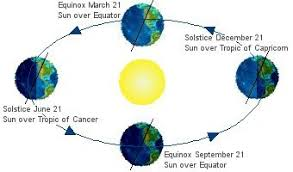Hello weather fans! In this week’s blog, let’s talk about this summer heat and the changing of the seasons!
The change of seasons.
Let’s take a moment to discuss the changing of the seasons. As we enter summer, you may notice that the days are getting longer as the Earth orbits the sun. The Earth rotates around a tilted axis of 23 degrees. As the Earth orbits the Sun, this tilt causes seasonal changes.
As the Earth tilts toward the Sun, it receives more radiation, resulting in summer! ! On June 21, the Sun is at its highest point as the Northern Hemisphere is tilted toward the Sun. In winter, the Northern Hemisphere moves away from the sun. The high angle of the sun in summer allows land and oceans to absorb more heat. Earth's seasons are determined by its tilt, not changes in its orbit.
The 4th of July weekend is here and summer has just begun. Temperatures are expected to be in the upper 80s and lower 90s. Did you know that heat is the number one cause of extreme weather events? Yes, it’s the heat. This summer, the National Weather Service (NWS) launched a new tool called Heat Risk. It can predict heat-related illnesses within 24 hours. By the way, isn’t it getting hotter and hotter? What do other expert scientists and data say?
Through (NCEI) National Center for Environmental Information
Through (EPA) Environmental Protection Agency
When looking at current data trends from NCEI and EPA, we can see significant increases in temperatures each year. In the first chart, global average surface temperatures in May 2024 have been above average for 14 consecutive months. The second graph shows rising average annual temperatures in the United States, based on the 1901-2000 average. Both graphs show rising temperatures since the 1970s. The hottest decade is 2014-2023, and the hottest year is 2023. Rising temperatures are caused by the continued trapping of greenhouse gases and the building of more infrastructure.
What causes heat waves?
During the summer, as the jet stream moves further north, an area of high pressure often develops in the mid-atmosphere and creates a heat dome. High temperatures begin in June and August with the summer sun's high angle and accumulated heat. The high pressure pushes the air downward and traps the heat trying to escape, creating a heat dome. This can lead to so-called heat waves. A heat wave is a prolonged period of hot weather with temperatures above normal. The following data makes it clear that heat waves occur more frequently in the United States, especially in urban areas.
Through (EPA) Environmental Protection Agency
Overall, current data trends show that U.S. and global temperatures are increasing year by year. It is crucial to exercise caution on what is expected to be a very hot and humid day, as extreme heat can have serious health consequences. Therefore, it is important to develop innovative thermal management methods. One way to mitigate the effects of urban heat islands (areas where buildings and concrete absorb and retain heat) is to plant more trees and use lighter colors on roads and buildings. These measures help lower temperatures in cities compared with rural areas.
After the summer heat! First appeared on Blog.WeatherFlow.com.
